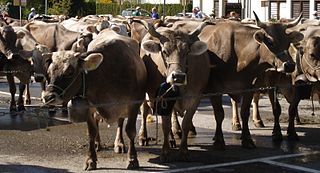
Solanum mauritianum is a small tree or shrub native to South America, including Northern Argentina, Southern Brazil, Paraguay and Uruguay. It has become a widespread invasive weed in Azores Islands, Cook Islands, Fiji, Hawai‘i, New Caledonia, Norfolk Island, Solomon Islands, Tonga, Réunion Island, Mauritius, Madagascar, Australia, New Zealand, India, Sri Lanka and several southern African countries. Its common names include earleaf nightshade, woolly nightshade, flannel weed, bugweed, tobacco weed, tobacco bush, wild tobacco and kerosene plant.

Solanum americanum, commonly known as American black nightshade, small-flowered nightshade or glossy nightshade is a herbaceous flowering plant of wide though uncertain native range. The certain native range encompasses the tropics and subtropics of the Americas, Melanesia, New Guinea, and Australia.

Solanum nigrum is a species in the genus Solanum, native to Eurasia and introduced in the Americas, Australasia, and South Africa. It is also known as black nightshade. Parts of this plant can be toxic to livestock and humans. Nonetheless, ripe berries and cooked leaves of edible strains are used as food in some locales, and plant parts are used as a traditional medicine. A tendency exists in literature to incorrectly refer to many of the other "black nightshade" species as "Solanum nigrum".
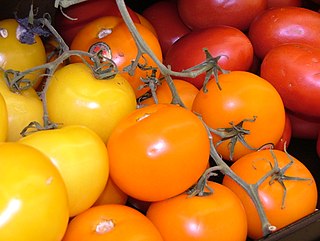
Lycopersicon was a genus in the flowering plant family Solanaceae. It contained about 13 species in the tomato group of nightshades. First removed from the genus Solanum by Philip Miller in 1754, its removal leaves the latter genus paraphyletic, so modern botanists generally accept the names in Solanum. The name Lycopersicon is still used by gardeners, farmers, and seed companies. Collectively, the species in this group apart from the common cultivated plant are called wild tomatoes.
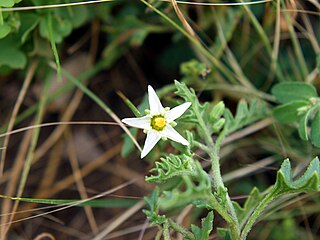
Solanum sarrachoides is a species of nightshade known as the hairy nightshade or leafy-fruited nightshade. In California, according to the Jepson Manual Solanum key, it is differentiated by its calyx (sepals) that are enlarged during fruit, but smaller when in flower.
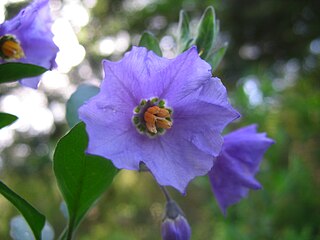
Solanum xanti, known commonly as chaparral nightshade, purple nightshade, and San Diego nightshade, is a member of the genus Solanum. It is native to the Western United States in Arizona, California, Nevada, and Oregon, and to northwest Mexico in Baja California.

Lycianthes is a genus of plants from the nightshade family (Solanaceae), found in both the Old World and the New World, but predominantly in the latter. It contains roughly 150 species, mostly from tropical America, with 35-40 species in Asia and the Pacific.
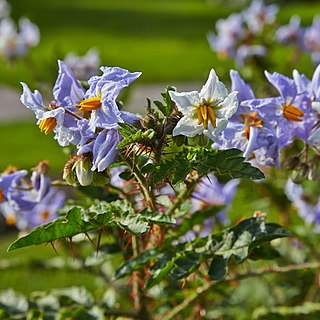
Solanum sisymbriifolium is commonly known as vila-vila, sticky nightshade, red buffalo-bur, the fire-and-ice plant, litchi tomato, or Morelle de Balbis.

Solanum bahamense, commonly known as the Bahama nightshade, is a plant in the nightshade family. It is native across the West Indies, from the Florida Keys east to Dominica. It is a common species in coastal habitats, often on calcareous soils.

Solanum citrullifolium is a species of nightshade commonly known as the watermelon nightshade, as its leaves somewhat resemble those of a watermelon plant. It is a white-stemmed shrub with purple star-shaped flowers. It is native to the southern United States and it is grown in home gardens as an ornamental plant.
Solanum lanceolatum, with the common names orangeberry nightshade and lanceleaf nightshade, is a species of nightshade. It is native to regions of South America, including the Cerrado ecoregion of the Tropical and subtropical grasslands, savannas, and shrublands biome, primarily in Brazil.

Solanum physalifolium, known as hoe nightshade, Argentine nightshade, green nightshade and hairy nightshade, is a species in the family Solanaceae. Native to Argentina, Bolivia and Chile, it is widely naturalized in Australia, New Zealand, Europe, western Canada and the north western United States. Solanum physalifolium has been widely but incorrectly known as Solanum sarrachoides, a different species. It has been listed as a noxious weed in the US states of Kansas and Michigan under this misapplied name.
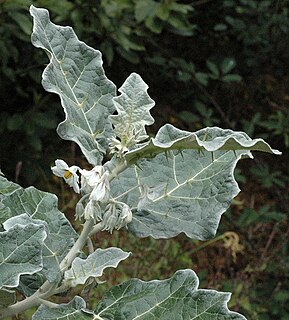
Solanum marginatum is a species of nightshade known by the common names purple African nightshade and white-margined nightshade. It is native to Ethiopia and Eritrea, and it is known on other continents as an introduced species and sometimes a weed. It is a hairy shrub growing up to two meters tall. The large, distinctive, gray-green leaves are wavy along the edges, woolly on the undersides, and measure up to 18 centimeters long. The veins are white and lined with large, widely spaced prickles. The inflorescence contains several white flowers, hanging or nodding bisexual flowers and erect staminate flowers with large yellow anthers. The fruit is a yellow berry up to 5 centimeters wide.

Solanum triflorum is a species of nightshade known by the common names cutleaf nightshade and small nightshade. It is native to Argentina, but it is known on other continents, including Europe and Australia, as an introduced species and sometimes a weed. It is present throughout much of North America, where it is possibly non-native as well. It grows in many types of habitat, including disturbed areas. It is an annual herb producing spreading, decumbent stems up one meter long. It is hairy, the hairs sometimes associated with glands. The leaves are a few centimeters long and are deeply cut into toothlike lobes. The inflorescence bears two or three flowers each just under a centimeter wide when fully open. The flower is usually white, but is occasionally purple-tinged. The fruit is a berry roughly a centimeter wide.

Solanum diphyllum, commonly known as the twoleaf nightshade, is a species of nightshade native to the Americas. It is cultivated as an ornamental plant for its clusters of dark green round fruits that turn a bright yellow when ripe.

Solanum tampicense, also known as wetland nightshade, aquatic soda apple, and scrambling nightshade, is a perennial in the Solanaceae or Nightshade Family. It can exist as a vine, tree, or shrub and is native to the West Indies and Central America. It is classified as a noxious weed by the United States Department of Agriculture and by several states and is known as an invasive species in the state of Florida.

African nightshades are several species of plants in the section Solanum of the genus Solanum, that are commonly consumed as leafy vegetables and herbs. African nightshades are grown in both high and lowland areas in West and East Africa, particularly in Nigeria and Cameroon. There is a large variation in diversity of the African nightshades, which have many nutritional and medicinal benefits, even though the family of nightshade is commonly known as comprising dangerous weeds or poisonous plants. Species known as African nightshade include Solanum scabrum, Solanum villosum, Solanum nigrum, and Solanum americanum. Other common names for African nightshade are Black nightshade and Narrow-leaved nightshade. Local names of African nightshade include mnavu (Swahili), managu (Kisii), namasaka (Luhya), osuga (Luo), isoiyot (Kipsigis), kitulu (Kamba), ormomoi (Maa), ndunda (Taita), and nsugga (Luganda).
Tall nightshade is a common name for several plants and may refer to:




